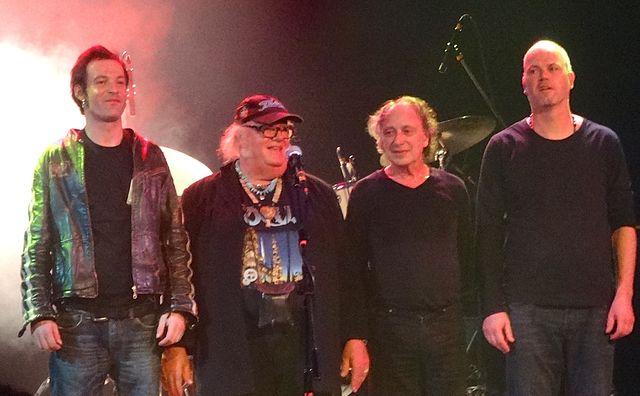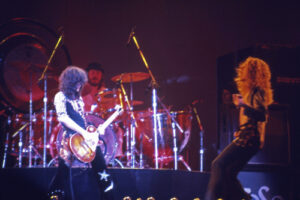
Photo: Louis Panassié, CC BY-SA 3.0 <https://creativecommons.org/licenses/by-sa/3.0>, via Wikimedia Commons
As a bandleader, composer, arranger and pianist, the accomplishments of Duke Ellington (1899-1974) are difficult for anyone else to equal. In 1929 he had one of the top five bands in jazz. The same can be true of him in 1939, 1949, 1959 and even 1969. Leader of his orchestra (which never broke up) for 49 years, Ellington wrote thousands of compositions, ranging from dozens that became standards (placing him on the same level as George Gershwin, Cole Porter and the other top songwriters) to suites. An innovative arranger who had his own sound by late-1926, Ellington loved to combine together primitive soloists with virtuosos, blending together very different tones to achieve unique ensembles. He was also one of the few pianists of the 1920s to continue evolving into the 1960s, always sounding modern while never losing his musical personality. His recording discography is enormous since he recorded steadily throughout his career with his music not only captured on studio recordings for labels but on live concerts, radio broadcasts, and private recordings.
Edward Kennedy Ellington, who picked up the lifelong nickname of Duke early in life due to his classy nature, was born in Washington D.C. While he had piano lessons when he was seven, he had planned to be an artist until he was attracted to the lifestyle of ragtime and jazz pianists and show business in general. While he knew few songs at the time, in 1917 he took out the largest ad in the Yellow pages of the phone book about his nonexistent band. Soon he was leading several orchestras, making nightly appearances with each of them where he would play the two songs that he knew!
Fortunately he rapidly developed his playing and writing within the next few years and, after a brief visit in 1922, he moved to New York in 1923 to join Elmer Snowden’s Washingtonians. After a money dispute, Ellington took over the band, made his debut recordings in 1924, had a yearlong engagement at the Kentucky Club, and in late 1927 won an audition to have his orchestra become the house band at the prestigious Cotton Club. The nightly radio broadcasts and his steady flow of new compositions and atmospheric arrangements soon made him famous.
# 1 – Early Ellington – 1927-34 (Bluebird)
By the late 1920s, Duke Ellington was recording prolifically for several labels, often using a pseudonym so as to disguise his identity although one cannot imagine mistaking his music for anyone else’s. This CD has some of his finest recordings from a seven-year period including definitive versions of “Black And Tan Fantasy,” “Creole Love Call,” “Mood Indigo,” and his early theme song “East St. Louis Toodle-oo.” A highpoint is his remarkable musical depiction of a train ride on “Daybreak Express.” The plunger mute mastery of trumpeter Bubber Miley (succeeded in 1929 by Cootie Williams) and trombonist Tricky Sam Nanton resulted in otherworldly sounds that were dubbed “jungle music.”
Steely Dan covered this one……….
# 2 – Okeh Ellington (Columbia)
This two-CD set has many of the titles heard on Early Ellington but these are different versions with equally rewarding solos and ensembles, plus Duke’s first two solo piano recordings. Those who want even more Ellington from this fertile period are advised to get Bluebird’s Jungle Nights In Harlem and Jubilee Stomp plus Decca’s three-CD set Early Ellington (1926-31). None of the performances on these releases duplicate each other.
# 3 -The Duke’s Men: Small Groups, Vol. 1 (Columbia)
While the swing era (which began in 1935) resulted in many big bands being formed, Ellington’s was considered in its own category and really had no competition. In fact, many of the other orchestras added some of Duke’s songs to their repertoire. This two-CD set features small groups taken out of the Ellington Orchestra during 1934-38 (often with Duke on piano) and puts the spotlight on such players as altoist Johnny Hodges, cornetist Rex Stewart, trumpeter Cootie Williams, and clarinetist Barney Bigard.
# 4 -The Blanton-Webster Years (Bluebird)
Many critics consider Ellington’s band of 1940-42 to be his finest. Among its stars were the first significant jazz bass soloist (Jimmy Blanton) and tenor-saxophonist Ben Webster. Arranger-composer-pianist Billy Strayhorn joined Ellington in 1939 and both added new songs to the band’s book (including its new theme “Take The ‘A’ Train”) and inspired Ellington to write many new originals of his own. This three-CD set has all of the master takes from the period and it is overflowing with three-minute gems.
# 5 – Black, Brown and Beige (Bluebird)
Covering the often underrated 1944-46 period (after Webster had departed and Blanton had passed away), the music on this three-CD set is pretty much on the same level as the Blanton-Webster Years, including excerpts from Ellington’s nearly hour-long masterwork “Black, Brown and Beige.” Other sets from the era that are highly recommended are releases of Ellington’s Carnegie Hall concerts of 1943, 1944, 1946 and 1947, particularly the 1943 three-CD set which includes the entire “Black, Brown and Beige.”
# 6 – Uptown (Columbia)
While sometimes thought of as Ellington’s “off period” due to Johnny Hodges and trombonist Lawrence Brown leaving the orchestra and the public’s tastes in the early 1950s moving away from big bands, Duke continued to create timeless music. Uptown from 1951-52 has a Louie Bellson drum feature (“Skin Deep”), the “Harlem Suite,” a swinging version of “Perdido” featuring trumpeter Clark Terry, “The Mooche,” the two-part “Controversial Suite” (contrasting New Orleans jazz with a somber Stan Kenton-type piece), and Betty Roche’s classic bebop vocal on “Take The ‘A’ Train.”
# 7 – Ellington At Newport (Columbia)
Duke Ellington had been out of the limelight for a few years although still working and recording regularly. However his performance at the 1956 Newport Jazz Festival caused a sensation that fueled the rest of his career. On “Diminuendo and Crescendo In Blue,” he turned tenor-saxophonist Paul Gonsalves loose during a medium-tempo blues and Gonsalves took 27 choruses that drove the crowd wild and resulted in headlines saying that Ellington was back. The rest of this two-CD set, taken from a period when Duke had 11 major horn soloists (most bands have four) is also mostly excellent.
# 8 -The Far East Suite (Bluebird)
From 1966, this nine-part suite (of which “Isfahan” became a jazz standard) was one of the most creative written by Duke Ellington and Billy Strayhorn.
# 9 – And His Mother Called Him Bill (RCA)
Billy Strayhorn’s death in 1967 hit Ellington hard. Typically he threw his emotions into his music and the result is this inventive and inspired set of Strayhorn compositions which includes “Raincheck,” “Lotus Blossom,” and “Blood Count.”
# 10 – Seventieth Birthday Concert (Blue Note)
While Duke Ellington preferred to look forward, this two-CD live set from 1969 has him exploring many of his earlier numbers but with fresh arrangements and solos. The exciting versions of “Rockin’ In Rhythm” and “Take The ‘A’ Train,” three features for altoist Johnny Hodges, a long medley of Duke’s hits, and some numbers with guest organist Wild Bill Davis work well. But it is the rather incredible high-note chorus by trumpeter Cat Anderson which climaxes “Satin Doll” that is most memorable. It reminds one that there will never be another Duke Ellington.
———————————–
Scott Yanow, jazz journalist/historian and author of 11 books including Bebop, Swing, Trumpet Kings, Jazz On Film, and Jazz On Record .1917-76
Check out our site for more great jazz articles by Scott Yanow on Miles Davis, John Coltrane and Charlie Parker.

Photo: Hans Bernhard (Schnobby), CC BY-SA 3.0 <https://creativecommons.org/licenses/by-sa/3.0>, via Wikimedia Commons













































I have Scott’s dynamite book on jazz guitarists and it has turned me toward a lot of great players I either didn’t give much time to or had never heard of. So being a fan of Duke Ellington myself I’ll have to check out a few of these albums, and I’m proud I have one (“Uptown”) in addition to a very good two CD greatest hits package and “Blues In Orbit”.